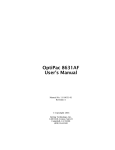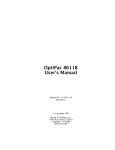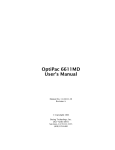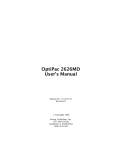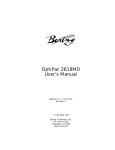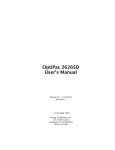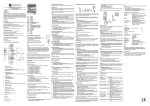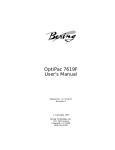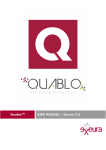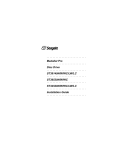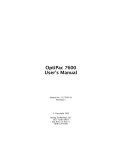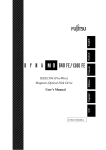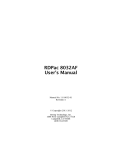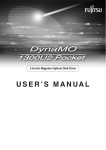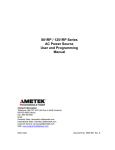Download OptiPac-3 6622SX User`s Manual
Transcript
OptiPac-3 6622SX User's Manual Manual No. 11-16622-80 Revision 1 © Copyright 2006 Bering Technology, Inc. 1400 Dell Avenue, Suite B Campbell, CA 95008-6620 (408) 364-6500 OVERVIEW Important Notice Important Notice Copyright © 2006 by Bering Technology, Inc. All rights reserved. No part of this document may be reproduced in any way without the express written permission of Bering Technology, Inc. Printed in the United States of America. The information contained in this document is subject to change without notice. Every reasonable precaution has been taken in the preparation of this manual to insure its accuracy. However, Bering Technology, Inc. assumes no liability resulting from any errors or omissions in this manual, or from the use of the information contained herein, nor does it make a commitment to update the information contained herein. OptiPac is a trademark of Bering Technology, Inc. HP is a trademark of Hewlett Packard Corp. Important FCC Information This peripheral device generates and uses radio frequency energy and if it is not installed and used properly, that is, in strict accordance with this manual, it may cause interference to radio and television reception. It has been type tested and found to comply with the limits for a Class-A computing device in accordance with the specifications in subpart J of part 15 of FCC Rules, which are designed to provide reasonable protection against such interference when operated in a commercial environment. However, there is no guarantee that interference will not occur in a particular installation. Operation of this equipment in a residential area is likely to cause interference and is up to the user, at his own expense, to take whatever measures may be required to correct the interference. You can test to see whether this equipment does cause interference with radio or television reception by turning the disk drive off and on. If it is causing interference, try to correct the problem by one or more of the following measures: • Be sure you're using shielded interconnect cables. • Reorient the receiving antenna. • Relocate the drive with respect to the receiver. • Move the receiver away from the disk drive, or vice versa. • Plug the computer into a different outlet so that the computer and receiver are on different circuits. If necessary, consult your dealer or an experienced radio/television technician for additional suggestions. You may also find a booklet prepared by the Federal Communications Commission helpful. It is entitled How to Identify and Resolve Radio-TV Interference Problems. Request Stock No. 004-000-00345-4, from the U.S. Government Printing, Washington, D.C., 20402. Warning: CAUTION LASER To prevent fire or shock hazard, do not expose the unit to rain or moisture. To avoid electrical shock, do not open the cabinet. Refer servicing to qualified personnel only. The OptiPac product is classified as a CLASS 1 LASER PRODUCT. A CLASS 1 LASER PRODUCT label is located on the internal drive mechanism. OptiPac-3 6622SX User's Manual iii OVERVIEW Printing History Printing History New revision levels of the manual indicate a new rewrite of the manual. This may include new installation instructions for a particular operating system, or a new ROM version of the OptiPac-3 subsystem which affects functionality. You can determine the ROM version of your OptiPac-3 by using the front panel LCD controls. See chapter 4 for details. If you have upgraded your OptiPac-3 and the LCD functions no longer match those described in this manual, you should contact Bering Customer Service to determine the proper revision of the OptiPac-3 6622SX User’s Manual required for your OptiPac-3 subsystem. Date Rev iv = = Date this manual was printed Revision level of this manual Date Rev Mar 2006 1 OptiPac-3 6622SX User's Manual Changes to manual Preliminary printing OVERVIEW Warranty Statement Warranty Statement OptiPac-3 products sold in the U.S.A. and Canada carry a standard one year warranty against defects in materials and workmanship.* During the warranty period, Bering will, at its option, repair or replace equipment which proves to be defective. OptiPac-3 cartridge media is warranted against defects for one year from the date of purchase. If the media becomes defective, Bering will replace it upon receipt of the defective media from the customer. All repairs will be performed at the factory. Any other arrangement, such as onsite service, will be at your expense. Before any product is returned for repair, a Return Materials Authorization number (RMA#) must first be obtained from a Customer Service representative. Customer Service Bering Technology, Inc. 1400 Dell Avenue, Suite B Campbell, CA 95008-6620 (408) 364-6500 FAX (408) 364-6501 Email: [email protected] The selection and use of media, supplies, and consumables is the customer's responsibility. Bering reserves the right to exclude from the warranty any damage caused by misuse of the product, unauthorized modification, shipping damage, non-Bering-approved media, interface, software, or cleaning supplies. NO OTHER WARRANTY IS EXPRESSED OR IMPLIED, INCLUDING, BUT NOT LIMITED TO, THE IMPLIED WARRANTIES OR MERCHANTABILITY AND FITNESS FOR A PARTICULAR PURPOSE. BERING SHALL NOT BE LIABLE FOR CONSEQUENTIAL DAMAGES, DIRECTLY OR INDIRECTLY RELATED TO THE USE OR PERFORMANCE OF BERING PRODUCTS. For products sold outside the U.S.A. and Canada, contact your local Bering distributor, representative, or dealer for warranty terms. OptiPac-3 6622SX User's Manual v OVERVIEW Configuration Settings Configuration Settings Use this table to record the configuration settings of your Bering OptiPac-3 Magneto-optical disk drive subsystem. Model __________________________ Part Number __________________ Serial Number __________________ Time Zone _______________ SCSI ID _______________ vi Parity checking R enabled R disabled Drive button R enabled R disabled 12/24 hour clock R 12 R 24 OptiPac-3 6622SX User's Manual OVERVIEW Table of Contents Table of Contents INTRODUCTION . . . . . . . . . . . . . . . . . . . . . . . . . . . . . . . . . . . . . . . . . 1 Features. . . . . . . . . . . . . . . . . . . . . . . . . . . . . . . . . . . . . . . . . . . . . 1 Compatibility . . . . . . . . . . . . . . . . . . . . . . . . . . . . . . . . . . . . . 1 Magneto-Optical Technology . . . . . . . . . . . . . . . . . . . . . . . . . . . 2 Conventions in this Manual . . . . . . . . . . . . . . . . . . . . . . . . . . . . 3 Unpacking . . . . . . . . . . . . . . . . . . . . . . . . . . . . . . . . . . . . . . . . . . . 4 INSTALLING THE OPTIPAC . . . . . . . . . . . . . . . . . . . . . . . . . . . . . . . . 5 Quick-Start Procedure . . . . . . . . . . . . . . . . . . . . . . . . . . . . . . . . . 5 Connecting the OptiPac Drive . . . . . . . . . . . . . . . . . . . . . . . . . . . 6 OPERATING THE DISK DRIVE & CARTRIDGE. . . . . . . . . . . . . . . . . . 7 6622SX Controls. . . . . . . . . . . . . . . . . . . . . . . . . . . . . . . . . . . . . . 7 MO Controls . . . . . . . . . . . . . . . . . . . . . . . . . . . . . . . . . . . . . . . . . 8 Loading a Cartridge . . . . . . . . . . . . . . . . . . . . . . . . . . . . . . . . 8 Compatibility. . . . . . . . . . . . . . . . . . . . . . . . . . . . . . . . . . 8 Ejecting a Cartridge . . . . . . . . . . . . . . . . . . . . . . . . . . . . . . . . 9 Ejecting a Cartridge Without Power . . . . . . . . . . . . . . . 9 Write-Protecting a Cartridge. . . . . . . . . . . . . . . . . . . . . . . . 10 OPTIPAC SYSTEM FUNCTIONS . . . . . . . . . . . . . . . . . . . . . . . . . . . . 11 System Menu. . . . . . . . . . . . . . . . . . . . . . . . . . . . . . . . . . . . . . . . 12 Main Menu. . . . . . . . . . . . . . . . . . . . . . . . . . . . . . . . . . . . . . . . . . 13 Unload Cartridge . . . . . . . . . . . . . . . . . . . . . . . . . . . . . . . . . 13 Backup . . . . . . . . . . . . . . . . . . . . . . . . . . . . . . . . . . . . . . . . . 14 Restore . . . . . . . . . . . . . . . . . . . . . . . . . . . . . . . . . . . . . . . . . 14 Configurations . . . . . . . . . . . . . . . . . . . . . . . . . . . . . . . . . . . 15 Utilities . . . . . . . . . . . . . . . . . . . . . . . . . . . . . . . . . . . . . . . . . 15 Display Time and Messages . . . . . . . . . . . . . . . . . . . . . . . . 15 Configurations Submenu. . . . . . . . . . . . . . . . . . . . . . . . . . . . . . 16 Change SCSI ID . . . . . . . . . . . . . . . . . . . . . . . . . . . . . . . . . . 16 Parity Checking . . . . . . . . . . . . . . . . . . . . . . . . . . . . . . . . . . 16 Change Drive Button . . . . . . . . . . . . . . . . . . . . . . . . . . . . . . 17 Use 12 / 24 Hour Clock . . . . . . . . . . . . . . . . . . . . . . . . . . . 17 Set Time . . . . . . . . . . . . . . . . . . . . . . . . . . . . . . . . . . . . . . . . 17 Set Date . . . . . . . . . . . . . . . . . . . . . . . . . . . . . . . . . . . . . . . . 18 Utilities Submenu . . . . . . . . . . . . . . . . . . . . . . . . . . . . . . . . . . . . 19 Hard Disk Utilities Submenu . . . . . . . . . . . . . . . . . . . . . . . 20 Show Hard Disk Information . . . . . . . . . . . . . . . . . . . . 20 Spin Down / Up Hard Disk. . . . . . . . . . . . . . . . . . . . . . 20 Verify Hard Disk . . . . . . . . . . . . . . . . . . . . . . . . . . . . . . 21 Format Hard Disk . . . . . . . . . . . . . . . . . . . . . . . . . . . . . 21 Erase Hard Disk. . . . . . . . . . . . . . . . . . . . . . . . . . . . . . . 22 Cartridge Utilities Submenu . . . . . . . . . . . . . . . . . . . . . . . . 23 Show Cartridge Information . . . . . . . . . . . . . . . . . . . . 23 Unload Cartridge. . . . . . . . . . . . . . . . . . . . . . . . . . . . . . 23 OptiPac-3 6622SX User's Manual vii OVERVIEW Table of Contents Verify Cartridge . . . . . . . . . . . . . . . . . . . . . . . . . . . . . . .23 Format Cartridge . . . . . . . . . . . . . . . . . . . . . . . . . . . . . .24 Erase Cartridge . . . . . . . . . . . . . . . . . . . . . . . . . . . . . . .25 External Disk Utilities . . . . . . . . . . . . . . . . . . . . . . . . . . . . .26 Show External disks . . . . . . . . . . . . . . . . . . . . . . . . . . .26 Verify External disk . . . . . . . . . . . . . . . . . . . . . . . . . . . .26 Import External disk . . . . . . . . . . . . . . . . . . . . . . . . . . .27 Tests Submenu . . . . . . . . . . . . . . . . . . . . . . . . . . . . . . . . . . .28 Test LCD Display . . . . . . . . . . . . . . . . . . . . . . . . . . . . . .28 CARING FOR THE DISK DRIVE & CARTRIDGE . . . . . . . . . . . . . . . .29 General Safeguards . . . . . . . . . . . . . . . . . . . . . . . . . . . . . . . . . . .29 Cartridge Care . . . . . . . . . . . . . . . . . . . . . . . . . . . . . . . . . . . . . . .30 TROUBLESHOOTING & SERVICE . . . . . . Before You Do Anything Else. . . . . . Error Codes and LCD Messages Fuse Replacement . . . . . . . . . . . . . . . If You're Still Having Problems . . . . . . . . . . . . . . . . . . . . . . . . .31 . . . . . . . . . . . . . . . . . . . . .31 . . . . . . . . . . . . . . . . . . . . .31 . . . . . . . . . . . . . . . . . . . . .31 . . . . . . . . . . . . . . . . . . . . .32 SPECIFICATIONS . . . . . . . . . . . . . . . . . . . . . . . . . . . . . . . . . . . . . . . .33 2.3GB Cartridge Disk Drive . . . . . . . . . . . . . . . . . . . . . . . . . . . .33 2.3GB Hard Disk . . . . . . . . . . . . . . . . . . . . . . . . . . . . . . . . . . . . .34 General. . . . . . . . . . . . . . . . . . . . . . . . . . . . . . . . . . . . . . . . . . . . .35 RACK MOUNT . . . . . . . . . . . . . . . . . . . . . . . . . . . . . . . . . . . . . . . . . .37 Installation. . . . . . . . . . . . . . . . . . . . . . . . . . . . . . . . . . . . . . . . . .37 INDEX . . . . . . . . . . . . . . . . . . . . . . . . . . . . . . . . . . . . . . . . . . . . . . . . .39 viii OptiPac-3 6622SX User's Manual 1 1 INTRODUCTION Congratulations on purchasing what we think is the finest removable cartridge system on the market. Bering OptiPac-3 drives are built for years of reliable service. We're sure you'll agree as you begin to work with your drive. Features The Bering OptiPac-3 6622SX subsystem is a 2.3GB Magneto-Optical removable cartridge disk drive with a 2.3GB hard disk compatible with Hewlett-Packard computers running operating systems that support SCSI disk drives. In this manual we refer to the Bering OptiPac-3 disk drive as OptiPac and all HP systems as computer, unless otherwise indicated. Note: The Bering OptiPac-3 6622SX magneto-optical cartridge drive supports 2.3GB, 1.3GB, and 640MB cartridges. These cartridges are available through Bering Technology’s sales department. Serving a wide range of storage needs, the OptiPac-3 comes in the following configuration. • 6622SX – a 2.3GB Magneto-Optical cartridge drive with a 2.3GB hard disk The OptiPac-3 6622SX subsystem uses a 3.5 -inch removable cartridge which can store 2.3GB. This means: • Your storage capacity is limited only by the number of cartridges you use. • Your data is portable and secure. Just remove the cartridge from the drive and take it with you, or store it in a safe place. • Your data cartridge is protected in a durable case. • Your OptiPac-3 can be used to back up the data on hard disks. • The hard disk can be backed up to the cartridge drive using a local backup function on the front LCD panel and controls. The OptiPac-3 provides fast, reliable storage that's always on hand. No software or hardware modifications are required. The OptiPac-3 supports the standard SCSI disk command sets. V DANGER: Compatibility Use of the OptiPac-3 other than as prescribed in this manual may result in exposure to hazardous invisible laser radiation if the case is open during operation. Avoid direct exposure to laser radiation. Do not operate the OptiPac-3 while the cover is removed. The OptiPac-3 subsystems read, write, and format ISO 128MB, 230MB, 640MB cartridges, and the GIGAMO 2.3 and 1.3GB MO cartridges. Use OptiPac-3 6622SX User's Manual 1 1 INTRODUCTION Magneto-Optical Technology the “Show Cartridge Information” function using the front panel control buttons to determine the capacity and statistics of each cartridge. MagnetoOptical Technology All of the Bering OptiPac disk drives are based on magnetic and optical technology. Like hard disks, a Magneto-Optical drive writes data to the cartridge using a strong magnet that changes the magnetic fields at specific locations from 1's to 0's and vice versa. But because of the polycarbonate surface of the cartridge, the magnet is not powerful enough to change the polarity of a bit by itself. This is where the optical part of the write process comes in. In order for the magnet to change the polarity of a bit, the area must be heated to a high temperature by a focused, fine-point laser. Because of the polycarbonate substrate on the cartridge, data stored on Magneto-optical cartridges is highly secure for a long period of time. The estimated storage life of data stored on this media is greater than twenty years. Also the magnetic head does not “float” next to the surface such as fixed disks. This means it is virtually impossible for the head to crash. 2 OptiPac-3 6622SX User's Manual INTRODUCTION Conventions in this Manual Conventions in this Manual We'll use the following conventions to make the information in this manual more clear and predictable: • Keys on the keyboard are indicated by capital letters enclosed in square brackets, e.g., [ENTER], regardless of whether the characters on your keys are actually capitalized. On the other hand, buttons on the OptiPac3 are indicated by underlined capital letters alone followed by the word button, e.g., ENTER button. • A font like this indicates text you should see on the LCD. The bold font will otherwise follow the conventions herein. • Italics in any type face, like this, have a limited number of possible meanings: Words as words, letters as letters, or numerals as numerals, e.g., “the word enter can be confused with the key on your keyboard, therefore we will use type in its place.” Titles of books, booklets, or disks, e.g., Bering OptiPac-3 6622SX User's Manual Symbolic of variable words, characters, or numerals. That is, something must be in the variable's place, but the exact contents vary with different situations and cannot be specified without knowing a particular situation. Variable is not synonymous with optional. Frequently the letter(s) n (for numerals), or x (for words or characters) are used to hold the place of the variable, e.g., “the program will respond that there are n widgets.” OptiPac-3 6622SX User's Manual 3 INTRODUCTION Unpacking 1 Unpacking Carefully unpack your OptiPac-3 near the spot where you want to set it up, noting the packing method as you go. Save the packing materials, they'll come in handy if you ever want to ship the unit. Besides this manual, you'll find: • the OptiPac-3 • a removable data cartridge • a SCSI terminator • a power cable • a warranty card If any item is missing, please call your dealer or call Bering Customer Service at (408) 364-6500. 4 OptiPac-3 6622SX User's Manual 2 INSTALLING THE OPTIPAC 2 This chapter describes the installation procedure for the OptiPac and is divided into two sections. The “Quick-Start Procedure” section enables experienced users to begin operation right away. The “Connecting the OptiPac Drive” section helps new users connect the disk drive before going on to the next chapter for additional operating instructions. Quick-Start Procedure This section describes the quick-start procedure to set up the OptiPac for use on a computer system. Most of the parameters are already set at the factory. There may be some adjustments necessary before the OptiPac can operate in your particular environment. Refer to your operating system manuals for information. 1. Turn off your computer. 2. Attach the SCSI cable to the computer’s SCSI Interface and the other end to either SCSI connector on the back panel of the OptiPac drive. 3. Install the SCSI terminator on the remaining SCSI connector on the back of the OptiPac. 4. Turn on the OptiPac and wait for the self-test to end. When the test ends without incident, the time and date should be displayed on the front panel LCD and the clock should be running. 5. Load a cartridge. 6. Format the cartridge from the Removable Utilities menu. This step is not necessary if the cartridge was previously formatted. 7. Turn on your computer. 8. Begin using the OptiPac. OptiPac-3 6622SX User's Manual 5 2 Connecting the OptiPac Drive V CAUTION: INSTALLING THE OPTIPAC Connecting the OptiPac Drive For specific installation and configuration instructions for your computer, refer to your computer’s operating manual. Turn off your computer and unplug the power cord from the wall outlet. Disconnect any other cables attached to the back panel of your computer that may be in your way. SCSI connectors AC receptacle with fuse holder and spare fuse Power ca SCSI cable Connect to computer Figure 2-1: Connecting the OptiPac 1. Turn off your computer and the OptiPac drive. 2. Connect the SCSI cable into either SCSI connector on the back panel of the OptiPac. 3. Attach a SCSI terminator to the other SCSI connector on the back panel of the OptiPac. 4. Plug the other end of the SCSI cable into the SCSI connector on your computer. 5. Connect the power cable to the back of the OptiPac. Make sure there is at least one inch of space around the back and two inches around the sides of the drive. 6. Plug the OptiPac and the computer into grounded electrical outlets or a surge protector. The OptiPac should be on the same circuit as your computer. V CAUTION: Make sure that other equipment or appliances which might generate electrical noise or a power surge (such as electric typewriters or heaters) are on separate circuits. 7. Turn on the OptiPac. 8. Set the SCSI ID to a unique address using the front panel LCD controls. 9. Turn on the computer, and any other peripherals. 6 OptiPac-3 6622SX User's Manual 3 OPERATING THE DISK DRIVE & CARTRIDGE 6622SX Controls 3 Figure 3-1 illustrates all controls and indicators required for operating the OptiPac 6622SX. 1. Press the POWER button on the front panel of the OptiPac. The LCD will display a self-test message and the disk drive model number. This operation should take less than a minute. If a cartridge is loaded, a read test will be performed. After the self-test is successfully completed, the time and date will be displayed on the LCD. LCD display Error LED/Hard disk access Drive Button and MO Activity LED Power switch Control buttons Figure 3-1: OptiPac 6622SX front panel Drive Button The drive button is always locked out. The cartridge will not eject when this button is depressed because the OptiPac controller has issued a lock command to the cartridge drive. The cartridge must be ejected using the Unload cartridge function in the LCD main menu. Hard Disk Access Indicator The hard disk access indicator is on the lower middle of the front bezel. Whenever the hard disk is accessed the LED will flash on. Error LED The Error LED turns red and stays illuminated when a system error is detected. This LED is also used as a hard disk access LED. It flashes green when the hard disk in the model 6622SX is accessed. OptiPac-3 6622SX User's Manual 7 3 MO Controls OPERATING THE DISK DRIVE & CARTRIDGE MO Controls The MO drive controls are simple. Drive/Eject Button Drive-Status Light (Flashes when drive is busy) Emergency Eject Hole Figure 3-2: MO controls Emergency Eject Hole In an emergency, such as a power outage, the cartridge can be manually ejected by inserting a tool into this opening. Read the complete instructions in the section titled “Ejecting a Cartridge Without Power.” Loading a Cartridge Loading a data cartridge is very much like loading a diskette. 1. Make sure the OptiPac is turned on before you load a cartridge. 2. Remove the cartridge from its plastic storage case. 3. Insert the cartridge into the drive slot with the label side up and push the cartridge straight in, keeping it parallel with the top and bottom of the drive. 4. Slide the cartridge all the way into the drive. The activity LED on the front of the removable drive will flash green as the drive spins up. After a brief test, the LED will extinguish when the drive is ready. Thereafter, the status LED will flash whenever the removable disk is accessed. V CAUTION: Compatibility 8 Never move or transport the OptiPac with a cartridge in the drive. This may damage the cartridge and cause read/write head damage. The OptiPac subsystems read, write, and format ISO 128MB, 230MB, 640MB cartridges, and the GIGAMO 2.3 and 1.3GB MO cartridges. For full hard disk backup capabilities, only the GIGAMO 2.3GB cartridges should be used. OptiPac-3 6622SX User's Manual OPERATING THE DISK DRIVE & CARTRIDGE MO Controls Ejecting a Cartridge It is important to remove the cartridge before you turn off the OptiPac. If you leave the cartridge in the drive, the shutter remains open and the recording media itself is vulnerable to dust. If the OptiPac is turned off prior to cartridge removal, the automatic disk spin-down operation does not occur and the cartridge disk will spin freely for up to 45 seconds. Attempting to remove the cartridge during this time may damage the media. The OptiPac must be turned on before you can unload a cartridge. If the Drive button is enabled, which is the default, just press the eject button on the front of the MO drive and proceed directly to step 3. If the drive button is disabled perform the following steps to eject a cartridge. 1. With the time function displayed on the LCD, push the SELECT button on the front panel. The Unload cartridge function(s) will be displayed. Unload cartridge 2. Push the ENTER button to execute the command. The cartridge will spin down and eject from the drive. Note: NEVER eject a cartridge while the file system is mounted on your operating system. 3. Remove the cartridge carefully and place it in the protective plastic storage case immediately. Remember to label and date the cartridge for future reference. Do not mark on labels with a graphite pencil. The graphite dust may contaminate the disk surface. Refer to Chapter 5, “Caring for The Disk Drive & Cartridge,” for further information on cartridge care. Ejecting a Cartridge Without Power While the OptiPac is not powered on, you can manually eject a cartridge. V CAUTION: Never manually eject a cartridge while the power is on. This can damage the drive and invalidate the warranty. 1. Wait for 45 seconds or more after the power is off. 2. Insert a cartridge eject tool (a paper clip may be substituted) into the emergency reject hole on the front of the drive. 3. Gently push the tool into the hole until the cartridge pops out. 4. Return the cartridge to its protective case for storage or transport. OptiPac-3 6622SX User's Manual 9 3 Write-Protecting a Cartridge OPERATING THE DISK DRIVE & CARTRIDGE MO Controls The MO cartridge can be physically write protected by pushing open the slide cover on the cartridge. This is similar to write protecting a floppy diskette. Read/write position Read only position (write-protected) Write-protect switch Figure 3-3: Cartridge write-protect switch 10 OptiPac-3 6622SX User's Manual 4 OPTIPAC SYSTEM FUNCTIONS 4 This chapter describes the OptiPac configuration and operating procedures. The OptiPac 6622SX features a push-button operation for performing configuration and operating procedures. This procedure is based on a hierarchical structure of system functions displayed on the disk drive's LCD. All procedures can be performed using the two front panel push-button controls: SELECT and ENTER. These instructions should be used in conjunction with your specific HP computer's configuration procedure.” Figure 4-1: Front panel LCD and push-button controls All system operations are performed by first selecting a function and then entering it for execution. The SELECT button enables you to scroll through all the available system functions and select desired choices. The ENTER button enables you to execute the chosen function. • To select a system function, press the SELECT button until the desired function appears on the LCD. • To execute the chosen function or display its options, press the ENTER button. • If you want to abort the current operation, press the SELECT and ENTER buttons simultaneously. The abort function is allowed only during certain operations. • To scroll or step backward in a menu, press and hold the SELECT button first and then the ENTER button. OptiPac-3 6622SX User's Manual 11 4 System Menu OPTIPAC SYSTEM FUNCTIONS System Menu This section contains a menu structure of the commands which can be accessed from the front panel LCD display and controls. Time / Date Unload cartridge Backup Restore Configurations Change SCSI ID Parity checking Change drive button Use 12 / 24 hour clock Set time Set date Return to main Utilities Bering model Firmware version / date Hard disk utilities Show hard disk information Spin down / up hard disk Verify hard disk Format hard disk Erase hard disk Previous menu Cartridge utilities Show cartridge information Unload cartridge Verify cartridge Format cartridge Erase cartridge Previous menu External disk utilities Show external disks Verify external disk Import external disk Previous menu Tests Test LCD display Return to main Display time and messages 12 OptiPac-3 6622SX User's Manual OPTIPAC SYSTEM FUNCTIONS Main Menu Main Menu The default display on the front panel LCD is the time/date. When the SELECT button is pressed, the first choice of the Main menu will be displayed. You can scroll the Main menu by repeatedly pressing the SELECT button. To execute the selected function or to enter the submenu, press the ENTER button. The time/date display will appear similar to the following display when the system is first powered on and when the unit is on-line: 4:15:12PM 10/12 Note: Attempting to perform any function on a new and/or unformatted cartridge may cause the following message to display: Media not initialized! The cartridge must be formatted from the Cartridge Utilities menu before it can be used. The following options are available from the Main menu of the OptiPac: Unload cartridge Backup Restore Configurations Utilities Display time and messages Unload Cartridge Use this function to unload the cartridge from the cartridge drive. 1. Use the SELECT button to choose the function you want to initiate from the Main menu: Unload cartridge 2. Press the ENTER button. A request is sent to the host system for permission to remove the cartridge. If the system grants the request or if there is no response for one second, the cartridge will be ejected. This is required for some operating systems and also prevents accidental ejection during cartridge use. If the cartridge is in use by the operating system, the following message will appear. Cartridge in use UNLOAD IT! (NO) 3. Press the SELECT button to select Yes, if need be; when Yes is selected, press the ENTER button to eject the cartridge. OptiPac-3 6622SX User's Manual 13 4 Backup OPTIPAC SYSTEM FUNCTIONS Main Menu This function is used to back up the OptiPac-3 hard disk to a cartridge. The entire image of the hard disk is copied onto one 2.3GB cartridge. A full backup can be made to one 2.3GB cartridge. Note: If you use a cartridge smaller than 2.3GB the backup will abort. 1. Insert a 2.3GB cartridge into the cartridge drive and wait for it to spin up. 2. Select Backup from the Main menu and press the ENTER button to choose this option. You will be asked: Backup to cartridge? No 3. If the cartridge contains a readable backup stored on it you will see: Overwrite backup Feb 16, 2005? No a. Press the SELECT button to toggle No to Yes. b. Press the ENTER button to continue when your choice is visible. If you entered No the cartridge will eject and the backup will abort. 4. As the backup progresses, the block number of the hard disk will be updated on the LCD: Copy HARD DISK block nnnnnn 5. To abort the function at any time, press and hold both the SELECT and ENTER buttons simultaneously until the following message appears: Abort received. wait … When backup is complete. You will see: Copy done at 10:30:33 am 6. Press the ENTER button to exit the Backup function and return to the Main menu. Restore Use this function to restore the hard disk in the OptiPac from a cartridge containing a previous backup. The entire image of the disk is restored from the cartridge generated by the Backup function. 1. Load a cartridge containing the desired backup image into the OptiPac-3. 2. With the Restore function displayed, press the ENTER button to choose the RESTORE function. You will see the following message: 14 OptiPac-3 6622SX User's Manual OPTIPAC SYSTEM FUNCTIONS Main Menu Restore to Wed Feb 16, 2005? No This message shows the date of the hard disk backup on the cartridge you inserted. 3. Press the SELECT button to choose Yes and press the ENTER button to continue. If you choose No and press the ENTER button the restore process will abort. As the restoration progresses the block address of the hard disk is updated with the following message: Copy CARTRIDGE block nnnnnn 4. To abort the function at any time, press and hold both the SELECT and ENTER buttons simultaneously until the following message appears: Abort received. wait … When the restoration is complete you'll see: Copy done at 10:30:33 pm 5. Press the SELECT button to complete and exit the Restore process. Configurations This function changes the SCSI ID, enables and disables parity checking, changes the drive button, selects the 24 hour clock format, and sets the date and time. See the “Configurations Submenu” section for detailed information. Utilities This function shows hard disk and cartridge information; verifies and formats the hard disk and cartridge; and erases the hard disk and cartridge data. Refer to the “Utilities Submenu” section for detailed information. Display Time and Messages This function exits the Main menu and displays the current date and time. OptiPac-3 6622SX User's Manual 15 4 Configurations Submenu OPTIPAC SYSTEM FUNCTIONS Configurations Submenu This function changes the SCSI ID, enables parity checking, enables the drive button, and sets the date and time. 1. Press the ENTER button when the Configurations function is displayed on the Main menu. The Configurations submenu will offer these functions: Change SCSI ID Parity checking (enable/disable) Change drive button (enable/disable) Use 24 / 12 hour clock Set time Set date 2. Press the SELECT button to scroll through the functions. To return to the Main menu, press the ENTER button when you see Return to main. Change SCSI ID This changes the SCSI address of the OptiPac. The SCSI address should be set to a unique address different from all other SCSI devices on the SCSI chain. To change the SCSI ID follow these instructions: 1. Press the ENTER button when the Configurations function is displayed on the Main menu. 2. Use the SELECT button to scroll through the selections until you see Change SCSI ID. 3. Press the ENTER button to select this option. The LCD display will now show the following message: SCSI ID= 6 4. Press the SELECT button to scroll through the available addresses (0–6) and then press ENTER at the desired setting. Parity Checking This function enables or disables parity checking on the SCSI Bus. The default is parity checking disabled. 1. Press the ENTER button when the Configurations function is displayed on the Main menu. 2. Use the SELECT button to scroll through the selections until you see Parity checking. 3. Press the ENTER button to select this option. The following message will appear: 16 OptiPac-3 6622SX User's Manual OPTIPAC SYSTEM FUNCTIONS Configurations Submenu Parity checking enable/disable 4. Press the SELECT button to toggle between enable and disable, then press the ENTER button to choose the desired option. Change Drive Button This function enables or disables the Eject/Drive button on the cartridge drive. The default setting has the Drive button disabled, permitting cartridge removal only by using the Unload cartridge function. This allows the OptiPac to communicate with the host system to request permission for cartridge removal. Enabling this function allows ejection of the cartridge by pressing the eject button on the front of the drive. 1. Press the ENTER button when the Configurations function is displayed on the Main menu. 2. Use the SELECT button to scroll through the selections until you see Change drive button. 3. Press the ENTER button to select this option. The following message will appear: disable / enable drive button 4. Press the SELECT button to toggle between disable and enable. 5. Press the ENTER button to select the desired function. The disable function is recommended. Use 12 / 24 Hour Clock This function changes the clock display on the front panel LCD from a 12 hour clock to a 24 hour clock or vice versa. 1. Press the ENTER button until the Use 12 / 24 hour clock function is displayed on the Configurations menu. 2. Press ENTER to select this option. 3. Use the ENTER button to toggle between 12 and 24. Then press the SELECT button to return to the menu. Set Time This function allows you to change the time. 1. With the Set time function displayed, press the ENTER button. You'll see: Set time 3:15:27 PM The actual time displayed will vary. The hour field will be blinking. 2. Press the SELECT button to increment the hour. OptiPac-3 6622SX User's Manual 17 4 OPTIPAC SYSTEM FUNCTIONS Configurations Submenu Holding the SELECT button will cause the hour to increment (through twelve hours) continuously. If you continue to hold down the SELECT button, incrementing will speed up. To decrement the hour, press and hold the SELECT button, and then press the ENTER button. Again, decrementing will be continuous and speeds up if you hold the buttons down. 3. When the correct hour is displayed, press the ENTER button. 4. SELECT and ENTER the correct minute setting just as you did the hour. 5. SELECT and ENTER the correct setting for seconds. 6. SELECT and ENTER the correct AM/PM setting. You will now be returned to the Set time option. Set Date This function allows you to change the date. 1. With the Set date function displayed, press the ENTER button. You'll see: Set date Wed Feb 16, 2005 The actual date displayed will vary. The day field will be blinking. 2. Press the SELECT button to increment the day. Holding the SELECT button will cause the day to increment (through the days of the week) continuously. If you continue to hold down the SELECT button, incrementing will speed up. To decrement the day, press and hold the SELECT button, and then press the ENTER button. Again, decrementing will be continuous and speeds up if you hold the buttons down. 3. When the correct day is displayed, press the ENTER button. The month field will start to blink. 4. SELECT and ENTER the correct month setting just as you did the day. 5. SELECT and ENTER the correct date setting. 6. SELECT and ENTER the correct year setting. After you have made this setting, you'll be returned to the Set date option. 18 OptiPac-3 6622SX User's Manual OPTIPAC SYSTEM FUNCTIONS Utilities Submenu Utilities Submenu This function shows hard disk and cartridge information; verifies, and formats the hard disk and cartridge; copies and erases hard disk and cartridge data: • MODEL NUMBER—Displays the model number of the OptiPac. • F/W VERSION—Displays the firmware version number and release date. • SERIAL NUMBER — Displays the serial number of the OptiPac. • HARD DISK UTILITIES—Shows hard disk information; spins down the hard disk; verifies, erases, and formats the hard disk. Refer to the “Hard Disk Utilities Submenu” section for detailed information. • CARTRIDGE UTILITIES—Shows cartridge information; unloads, verifies, erases, and formats the cartridge. Refer to the “Cartridge Disk Utilities Submenu” section for detailed information. • EXTERNAL DISK UTILITIES—Shows information about other disk units attached to the SCSI chain, tests other disk units, and imports an image of other disk units. • TESTS—Tests the LCD. Refer to the “Test Submenu” section for detailed information. To access and exit these utilities … 1. Press the ENTER button when the Utilities function is displayed on the Main menu. The Utilities submenu appears and displays the following functions: Model number F/W version Serial number Hard disk utilities Cartridge utilities External Disk Utilities Tests Return to main 2. Press the SELECT button to scroll through the information or functions. 3. When you see Return to main , press the ENTER button to return to the Main menu. OptiPac-3 6622SX User's Manual 19 4 Hard Disk Utilities Submenu OPTIPAC SYSTEM FUNCTIONS Utilities Submenu This function shows hard disk information; verifies, and formats the hard disk, and spins the hard disk down or up. 1. Press the ENTER button when the Hard disk utilities function is displayed on the Utilities submenu. The Hard disk utilities submenu then appears displaying the following functions: Show hard disk information Spin down/up hard disk Verify hard disk Format hard disk Erase hard disk Previous menu 2. Press the SELECT button to scroll through the information or functions. 3. You can return to the Utilities menu by pressing the ENTER button when you see Previous menu. Show Hard Disk Information This function displays information similar to the following list about the hard disk. Capacity in MB Sector size Date hard disk last formatted* Date hard disk last written* Date hard disk last accessed* * only if hard disk is formatted. 1. Press the SELECT button to scroll through each field. Spin Down / Up Hard Disk This function will spin the hard disk drive down or up. Using this function will help prevent wear on a drive which is constantly powered on. 1. Press the ENTER button to execute this function. If the drive is already spun down, you will see the following message: Spin up hard disk 2. Press the ENTER button to spin the drive up. The hard disk will spin up at the first sign of activity on the SCSI bus, or when the LCD front panel controls access the hard disk drive. CAUTION: 20 If the computer system attempts to access the OptiPac while it is spun down, the hard disk will automatically spin up, but the computer system may time-out before the disk is ready, causing a system error. OptiPac-3 6622SX User's Manual OPTIPAC SYSTEM FUNCTIONS Utilities Submenu Verify Hard Disk This function scans every sector on the hard disk for defects. If a bad sector is found, this function will terminate with the LCD showing the error. 1. Press the ENTER button to start. As the verification progresses, the block address is updated. The following message will appear: Verify DISK block nnnnnn 2. To abort the function at any time, press and hold both the SELECT and ENTER buttons simultaneously until the following message appears: Abort received. wait … 3. Release the buttons. The function will abort at the appropriate time and you'll see: User abort 4. Press the SELECT button to exit. When the verify is complete, the following message will appear: Hard disk verified 5. Press the SELECT button to return to the Hard disk utilities submenu. Format Hard Disk CAUTION: This function is used to format the hard disk if the FORMAT utility is not available in your host system. The Format Hard Disk function will erase all data on the hard disk. 1. Press the ENTER button when the Format disk function is displayed on the Hard disk utilities submenu. The Format hard disk submenu then appears displaying the following message: Erase entire media? NO 2. Press the SELECT button to toggle between YES and NO. 3. Select YES and press the ENTER button to continue. The following message will appear: Set bytes /sector 512 4. Press the SELECT button to toggle between 512 and 1024. OptiPac-3 6622SX User's Manual 21 4 OPTIPAC SYSTEM FUNCTIONS Utilities Submenu 5. Press the ENTER button to continue. The following message will appear showing the number of volumes (vols) and the sector size (bps = bytes per sector): 1 vols 512 bps continue? No If you choose No the FORMAT will abort and you'll be returned to the Hard disk utilities menu. 6. Use the SELECT button to select Yes and press the ENTER button to start the format process. The following message will appear: Formatting HARD DISK Formatting will take up to 1 hour. After the format a verify pass will occur. When the process is complete, the following message will appear: HARD DISK formatted 7. Press the SELECT button to return to the Hard disk utilities submenu. Erase Hard Disk CAUTION: This function will erase the entire hard disk by performing a security wipe delete. This wiping of data is done by filling the sectors with hexadecimal characters in sequential passes. The characters are written in the following sequence: 35, CA, F6. A verify pass is done after each write pass, for a total of 6 passes. This method prevents any traces of data from being read, even with sophisticated techniques. The erased hard disk will be unreadable and must be formatted again to be usable. 1. Press the ENTER button when the Erase disk function is displayed on the hard disk utilities submenu. The Erase hard disk submenu will appear and ask: Erase entire media? NO 2. Use the SELECT button to select YES and press the ENTER button to continue. Upon successful completion, the following message will appear: HARD DISK erased 3. Press the SELECT button to return to the Hard disk utilities submenu. 22 OptiPac-3 6622SX User's Manual OPTIPAC SYSTEM FUNCTIONS Utilities Submenu Cartridge Utilities Submenu This function shows cartridge information; locks and unlocks, verifies, and formats the cartridge. 1. Press the ENTER button when the Cartridge utilities function is displayed on the Utilities submenu. The Cartridge utilities submenu then appears displaying the following functions: Show cartridge information Unload cartridge Verify cartridge Format cartridge Erase cartridge Previous menu 2. Press the SELECT button to scroll through the information or functions. 3. You can return to the Utilities menu by pressing the ENTER button when you see Previous menu. Show Cartridge Information This function displays information similar to the following list about the cartridge. Capacity in MB Sector size Date hard disk last formatted* Date hard disk last written* Date hard disk last accessed* * Not displayed for unformatted cartridges. 1. Press the ENTER button to scroll through each field. Unload Cartridge This is the same as Unload cartridge in the Main menu. Verify Cartridge This function scans every sector on the cartridge for defects. If a bad sector is found, this function will terminate with the LCD showing the error. 1. Press the ENTER button to start. As the verification progresses, the block address is updated. The following message will appear: Verify CARTRIDGE block nnnnnn 2. To abort the function at any time, press and hold both the SELECT and ENTER buttons simultaneously until the following message appears: Abort received. wait … OptiPac-3 6622SX User's Manual 23 4 OPTIPAC SYSTEM FUNCTIONS Utilities Submenu 3. Release the buttons. The function will abort at the appropriate time and you'll see: User abort 4. Press the ENTER button to exit. When the verify is complete, the following message will appear: CARTRIDGE verified 5. Press the SELECT button to return to the Cartridge disk utilities submenu. Format Cartridge All new cartridges should be formatted with this utility before using on the computer system. This function is used to format the cartridge if the FORMAT utility is not available in your host system. 1. Press the ENTER button when the Format cartridge function is displayed on the Cartridge disk utilities submenu. The Format cartridge submenu then appears displaying the following message: Erase entire media? NO 2. Press the SELECT button to toggle from NO to YES. 3. Select YES and press the ENTER button to continue. The following message will appear: Set bytes /sector 512 4. Press the SELECT button to toggle between 512 and 1024. 5. Press the ENTER button to continue. The following message will appear showing the number of volumes (vols) and the sector size (bps = bytes per sector): 1 vol 512 bps continue? NO 6. Use the SELECT button to select YES and press the ENTER button to start the format process. The following message will appear: Formatting CARTRIDGE 24 OptiPac-3 6622SX User's Manual OPTIPAC SYSTEM FUNCTIONS Utilities Submenu Formatting will take up to 1 hour. After the format, a verify pass will occur. When the process is complete, the following message will appear: CARTRIDGE formatted 7. Press the SELECT button to return to the Cartridge disk utilities submenu. Erase Cartridge This function will erase the entire cartridge by performing a security wipe delete. This wiping of data is done by filling the sectors with hexadecimal characters in sequential passes. The characters are written in the following sequence: 35, CA, F6. A verify pass is done after each write pass, for a total of 6 passes. This method prevents any traces of data from being read, even with sophisticated techniques. This procedure may take as long as 48 hours to complete. CAUTION: The erased cartridge will be unreadable and must be formatted again to be usable. 1. Press the ENTER button when the Erase cartridge function is displayed on the Cartridge disk utilities submenu. The Erase cartridge submenu will appear and ask: Erase entire media? NO 2. Use the SELECT button to select YES and press the ENTER button to continue. Upon successful completion, the following message will appear: CARTRIDGE erased 3. Press the SELECT button to return to the Cartridge disk utilities submenu. OptiPac-3 6622SX User's Manual 25 4 External Disk Utilities OPTIPAC SYSTEM FUNCTIONS Utilities Submenu This function shows information about other disk units on the SCSI bus, verifies (tests) the external units, and imports data from external disk units to the OptiPac cartridge, or to the hard disk in the OptiPac. Warning: These utilities will not function if the OptiPac and other devices on the SCSI chain are connected to the computer and the computer is powered on. The OptiPac will lock up with a blank display. Disconnect the computer from the SCSI cable before using the External Disk Utilities. Ensure that the SCSI ID of the OptiPac is different from all other devices on the SCSI chain. We recommend a SCSI ID of 7 if the computer is disconnected or powered off. 1. Press the ENTER button when the External disk utilities function is displayed on the Utilities submenu. The External disk utilities submenu then appears displaying the following functions: Show external disks Verify external disk Import external disk Previous menu 2. Press the SELECT button to scroll through the information or functions. 3. You can return to the Utilities menu by pressing the ENTER button when you see Previous menu. Show External disks This function displays the following about the external disk: SCSI ID Manufacturer and Model Capacity and Sector Size 1. Press the SELECT button to scroll through each field. When the last device is completed, the following message will be displayed: No more disks This message is also displayed if no devices are attached to the OptiPac. Verify External disk This function reads the volume to ascertain the integrity of all sectors in the volume. 1. Press the ENTER button when Verify external disk is displayed on the External disk Utilities menu. The OptiPac will find the a drive on the SCSI chain and display a message similar to the following: 26 OptiPac-3 6622SX User's Manual OPTIPAC SYSTEM FUNCTIONS Utilities Submenu Verify ST34520 at 1? Yes 2. If this is the drive to be verified, press the ENTER button while Yes is displayed; otherwise press SELECT to toggle to No and press the ENTER button to find the next available device on the SCSI chain. When you select a drive a message similar to the following message will by displayed: Verify EXTERNAL block nnnnnn When the verify is complete the following message will be displayed: EXTERNAL verified Import External disk This function imports data from another disk drive to the MO cartridge in the OptiPac or the hard disk in the OptiPac. 1. Press the ENTER button when Import external disk is displayed on the External Disk Utilities menu. The OptiPac will find a drive on the SCSI chain and display a message similar to the following: ST34520 at 1 Import? No 2. If this is the drive to be imported to the OptiPac, press SELECT to toggle from No to Yes and press ENTER; otherwise, press ENTER while No is displayed to select another device. If you selected Yes a message similar to the following will be displayed: Import to hard disk? Yes 3. Press SELECT to toggle between Yes and No and then press the ENTER button. If you selected No, the display will change to “Import to cartridge.” When you select Yes a message similar to the following will display: Start the import? Yes 4. Press ENTER while Yes is displayed to start the import function. The progress is shown with the following message: Import EXTERNAL Record nnnnnn When the import is complete the following message will be displayed: Import done at 11:28:33AM OptiPac-3 6622SX User's Manual 27 OPTIPAC SYSTEM FUNCTIONS Utilities Submenu 4 Tests Submenu This function tests the LCD. 1. Press the ENTER button when the Tests function is displayed on the Utilities submenu. The Tests submenu will appear displaying the following function: Test LCD display 2. Press the SELECT button to scroll through the information or functions. 3. To return to the Utilities menu, press the ENTER button when you see Previous menu. Test LCD Display This function is used to make sure the LCD is working properly. 1. Press the ENTER button to start the test. All of the segments on the LCD will be turned on. If there are any missing segments (except the last character with an *), call the Bering Service Department for assistance. 2. Press the ENTER button again to exit. 28 OptiPac-3 6622SX User's Manual 5 CARING FOR THE DISK DRIVE & CARTRIDGE 5 This chapter describes how to care for your OptiPac disk drive. It is divided into two sections. The “General Safeguards” section tells you what to look out for. The “Cartridge Care” section describes ways to care for your cartridges. As long as you protect your OptiPac from hazards, it will provide you with years of service. General Safeguards You can preclude many problems by taking preventive measures. • The MO disk lens head should be cleaned every three months with the Bering MO cleaning kit (ACCS-3513). The lens is cleaned by inserting a head cleaning cartridge into the powered on drive. Brushes on the cleaning cartridge wipe dust and dirt off the lens while the head mechanism moves across the brushes. The cartridge will be ejected after approximately 15 seconds. • Avoid overheating by placing the OptiPac where adequate air flow can circulate around it. Be particularly careful to avoid blocking the cooling vent at the rear of the unit. • Make sure it is plugged into a grounded electrical outlet. Verify that the outlet is actually grounded. The OptiPac should be on the same circuit as your computer. • Make sure that other equipment or appliances which might generate electrical noise or a power surge (such as electric typewriters or heaters) are on separate circuits. • Do not expose you OptiPac to extreme heat or cold. Prolonged exposure to excessive heat, direct sunlight, or freezing conditions will harm the drive. • Keep it away from moisture, dirt, and contaminants such as spilled liquids, steam, or excessive dust. Do not smoke near the OptiPac. • Avoid exposure to magnetic fields such as those emitted by magnets, speakers, or telephone equipment. • Avoid bumping the OptiPac while it is running. • Always set the OptiPac upright on a flat surface. • Do not transport the OptiPac with a cartridge in the drive. • Use the spin-down function if the drive will not be accessed for long periods of time. This will save wear and tear on the drive spindle and promote a much longer life for the drive. You don't need to worry about leaving the OptiPac on for a long time it doesn't use much power. It's normal for the drive to feel warm (but not hot) after it's been running for a while. If the OptiPac does get hot, make sure the fan is running properly, the OptiPac-3 6622SX User's Manual 29 CARING FOR THE DISK DRIVE & CARTRIDGE Cartridge Care 5 vent at the rear is not blocked, and that the unit is placed where plenty of air can circulate around it. Cartridge Care V CAUTION: 30 Removable cartridges are highly reliable and have a very long service life if you care for them properly. • We recommend that each cartridge be cleaned using the Magneto Optical Cleaning Kit (ACCS-3513) every 3 months of continuous service, or 300 hours of use. • Store them properly. Remove the cartridge from the drive when you are not using it and store it in its protective case in a cool, dry, safe location. • Do not leave the cartridge in the OptiPac after it is powered down. This leaves the cartridge shutter open and makes the recording media itself vulnerable to dust. • Keep your cartridges clean and dry and out of harm's way. Protect cartridges fro dirt, spills, and smoke. Avoid opening the shutter of the cartridge since dust and dirt can be transferred to the disk media or to the inside of the drive. • Use them at correct temperatures. Avoid using the cartridges at extreme temperatures above 90° F (32° C) or below 60° F (16° C). To avoid permanently damaging data, the drive, cartridge, and room should all be about the same temperature when you insert the cartridge into the drive. • Do not expose cartridges to moisture or prolonged direct sunlight. • Do not move the drive with a cartridge loaded. • Do not drop the cartridge. • Label the cartridge clearly and make sure the label is securely attached before loading the cartridge. (Do not mark on labels with a graphite pencil. The graphite dust may contaminate the disk surface). • Never apply more than one label to a cartridge. • Apply a label only to the recessed area on the cartridge. Do not use defective or questionable cartridges on another OptiPac drive. You may spread the problem. OptiPac-3 6622SX User's Manual 6 6 TROUBLESHOOTING & SERVICE This chapter describes basic trouble-shooting procedures. It is divided into four sections: “Before You Do Anything Else,” “Error Codes and LCD Messages,” “Fuse Replacement,” and “If You're Still Having Problems.” Before You Do Anything Else Often, problems you're having can be resolved by verifying that: • The power cord is securely connected to the OptiPac and a wall outlet. • The power is switched on, and the AC fuse in the back of the drive is not blown. • None of the pins on the cable connectors are loose, broken, or shorted. • All cables are installed correctly. • The cartridge has been properly formatted. • Each peripheral connected to your computer has a unique address. Error Codes and LCD Messages Occasionally, after installing an OptiPac, the system will display a disk initialization error code upon start up. It is sometimes possible to solve the problem by following the LCD instructions. Sometimes the LCD will display an error code in the form of a number. This error code indicates a problem that may be associated with another hardware device other than the OptiPac. If this occurs, shut down your system and restart it again. If the problem still occurs, contact Bering Technical Support at (408) 364-6500. Fuse Replacement If the drive fails to power on the AC fuse may be blown. The fuse is located in the AC input jack. Spare fuse Fuse Figure 6-1: Replacing the AC fuse OptiPac-3 6622SX User's Manual 31 TROUBLESHOOTING & SERVICE If You're Still Having Problems 6 If You're Still Having Problems If you are able to start up from another drive but not the OptiPac, or from a cartridge and not the hard drive, the system files on the OptiPac hard drive may be damaged. START-UP PROBLEMS If you're unable to start up from an OptiPac, try starting up the computer with a different drive if available. If you're still unable to start up, the problem may be with the computer rather than the OptiPac. Refer to the troubleshooting section in your computer manual for more information. WHEN ALL ELSE FAILS... If you still have problems after following the procedures in this chapter, call Bering Technical Support at (408) 364-6500. When you call be ready to tell the service representative: • The model number and serial number of the OptiPac, the firmware version of the OptiPac, the type of computer you're using, the operating system, and the software version. • Any error messages that have appeared. • A description of the problem(s) and the steps you've taken to correct it. Bering Customer Service can be reached by several methods. The mailing/shipping address and phone numbers are: Bering Technology, Inc. Customer Service/Technical Support 1400 Dell Avenue, Suite B Campbell, CA 95008-6620 (408) 364-6500 FAX: (408) 364-6501 Email: [email protected] V CAUTION: 32 Never remove the cover of the OptiPac box. This voids the warranty. OptiPac-3 6622SX User's Manual A A SPECIFICATIONS 2.3GB Cartridge Disk Drive 2.3GB MO Cartridge The specifications listed on this page are for a 2.3GB cartridge. The 2.3GB, 2048bps cartridge is identical in capacity to the hard disk. PERFORMANCE Rotation speed 2.3GB cartridge 3,214 other cartridge 4,558 Average seek time 23 HP-IB Burst transfer rate 1 HP-IB Average transfer rate 940 MTBF 120,000 Data reliability <1 nonrecoverable error LOGICAL SIZE (as seen by computer) Cylinders Heads Sectors Sector size rpm rpm ms, read MB/sec KB/sec Power On Hours in 1012 bits read 3473 36 34 512 bps ENVIRONMENTAL (operational) Temperature Relative humidity Vibration Shock Altitude 5° to 45° 10 to 85 5 to 500 2 0 to 10,000 0 to 3,048 C % non-condensing Hz, 0.4 G's p-p G, 10 ms half sine pulse feet meters (non-operating) Temperature Relative Humidity Vibration Shock (cartridge removed) transport Altitude -20° to 60° 5 to 90 5 to 500 5 50 0 to 40,000 0 to 12,192 C % non-condensing Hz, 1 G p-p G's at 10 ms half sine pulse G’s at 10 ms half sine pulse feet meters LASER DIODE Type Wavelength Output Power Classification Semiconductor Laser 785nm, Continuous 30mW (max) Class 1 (IEC. 825) GaAIAs OptiPac-3 6622SX User's Manual 33 A SPECIFICATIONS 2.3GB Hard Disk 2.3GB Hard Disk PERFORMANCE Rotation speed Average latency Minimum seek time Average seek time Maximum seek time MTBF LOGICAL SIZE (as seen by computer) Cylinders Heads Sectors Sector size ENVIRONMENTAL (operational) Temperature Temperature gradient Relative humidity Vibration Shock Altitude (non-operating) Temperature Relative Humidity Vibration Shock Altitude 34 OptiPac-3 6622SX User's Manual 7200 5.6 2 12.5 22 300,000 rpm ms ms ms ms Power On Hours 3473 36 34 512 bps 5° to 55° 41° to 131° 15 ° 59 ° 20 to 80 1 10 0 ~ 3,000 0 ~ 10,000 C F C/hour F/hour % non-condensing G, 5 to 250Hz G, 10 ms max meters feet -40° to 70° -40° to 158° 5 to 90 2 75 0 ~ 12,000 0 ~ 40,000 C F % G, 5 to 250 Hz G, 10 ms max meters feet SPECIFICATIONS General General Power Requirements Line voltage Line frequency Current Fuse General Dimensions Interface 96 - 240 47 - 63 0.5 “Slow blow” 1.6A, 250V SCSI, Common Command Set (CCS) Dimension Shipping weight Accessories volts Hz Amps 3" x 12.8" x 14" 8.25 x 32.5 x 35.5 cm 25 lbs. 11.3 Kg Cartridge MO, 2.3GB Cartridge MO, 2.3GB, 5 pack ACCS-3073 ACCS-3074 Rack Mount Kit - 19" ACCS-7206 OptiPac-3 6622SX User's Manual 35 A 36 SPECIFICATIONS General OptiPac-3 6622SX User's Manual B RACK MOUNT Installation B If you purchased the rack mount kit, ACCS-7206 from Bering, these instructions will show the installation procedures. It fits in a standard 19” rack cabinet. The front is a 3.5 in. panel with the holes on 3 in. centers. The holes on the sides of the rack are 3.625 centers for installation of a standard C300S-22 slide rail. The following instructions are for installing the drive into a rack without slide rails. 1. Remove the front feet from the Bering drive by removing two screws in each foot. 2. Mount the Bering drive to the rack mount shelf with four (4) 8-32x¼ screws inserted from the bottom through the shelf into the bottom of the drive. Remove front feet from drive Figure B-1: Attaching the drive to the rack mount assembly This step may be performed by turning the drive upside down and placing the shelf on the drive while aligning the screw holes. OptiPac-3 6622SX User's Manual 37 B V CAUTION RACK MOUNT Installation The following steps require two people to install the unit in a cabinet. The shelf requires 3.5 inches of vertical clearance. 3. Insert the shelf with the Bering drive into the cabinet and hold it in place. 4. Insert the four (4) 10-32x5/16 screws from the front through the holes in the cabinet. Screw the 10-32 nuts on the screws from the rear of the panel and tighten. 10-32x5/16, 4 places Figure B-2: Installing the rack mount in the chassis 38 OptiPac-3 6622SX User's Manual INDEX A Access indicator 7 Accessories 35 B Backup 14 C Cartridge Erase 25 Format 24 Loading 8 Show information 23 Specifications 33 Unload 13, 23 Unloading 9 Verify 23 Cartridge utilities submenu 23 Change drive button 17 Change SCSI ID 16 Clock, 12 / 24 setting 17 Configurations submenu 16 Controls 7 Customer Service 32 D Date Setting 18 Display Time and Messages 15 Drive button 17 E Emergency eject hole 8 Erase cartridge 25 Erase hard disk 22 Error LED 7 External disk Import 27 Show 26 Verify 26 F FCC iii Firmware version 19 Format cartridge 24 Format hard disk 21 Fuse replacement 31 H Hard disk Erase 22 Format 21 Show information 20 Spin down 20 Verify 21 Hard disk access indicator 7 I Import external disk 27 L LCD Backup 14 Cartridge utilities submenu 23 Change drive button 17 Change SCSI ID 16 Configurations submenu 16 Erase cartridge 25 Erase hard disk 22 F/W version 19 Format cartridge 24 Format hard disk 21 Import external disk 27 Model number 19 Parity checking 16 Restore 14 Set date 18 Set time 17 Show cartridge information 23 Show external disks 26 Show hard disk information 20 Spin down / up hard disk 20 Test LCD display 28 Unload cartridge 13, 23 Use 24 hour clock 17 Utilities submenu 19 Verify cartridge 23 Verify external disk 26 Verify hard disk 21 LCD Menu 12 LCD messages 31 OptiPac-3 6622SX User's Manual 39 INDEX LED, error 7 V M Verify cartridge 23 Verify external disk 26 Verify hard disk 21 Magneto-Optical technology 2 Main menu 13 Media not initialized, message 13 Menu, system 12 Model number 19 N New cartridge 13 O Operation 7 P Parity checking 16 R Rack mount installation 37 Rack mount kit 35 Restore 14 ROM version 19 S SCSI ID, changing 16 Serial number 19 Set date 18 Set time 17 Show cartridge information 23 Show external disks 26 Show hard disk information 20 Specifications 2.3GB cartridge drive 33 2.3GB Hard disk 34 General 35 Spin down / up hard disk 20 T Table of Contents vii Technical Support 32 Test LCD display 28 Tests submenu 28 Time Setting 17 U Unload cartridge 13, 23 Unpacking 4 Utilities submenu 19 40 OptiPac-3 6622SX User's Manual W Warranty statement v Write protection 10
















































